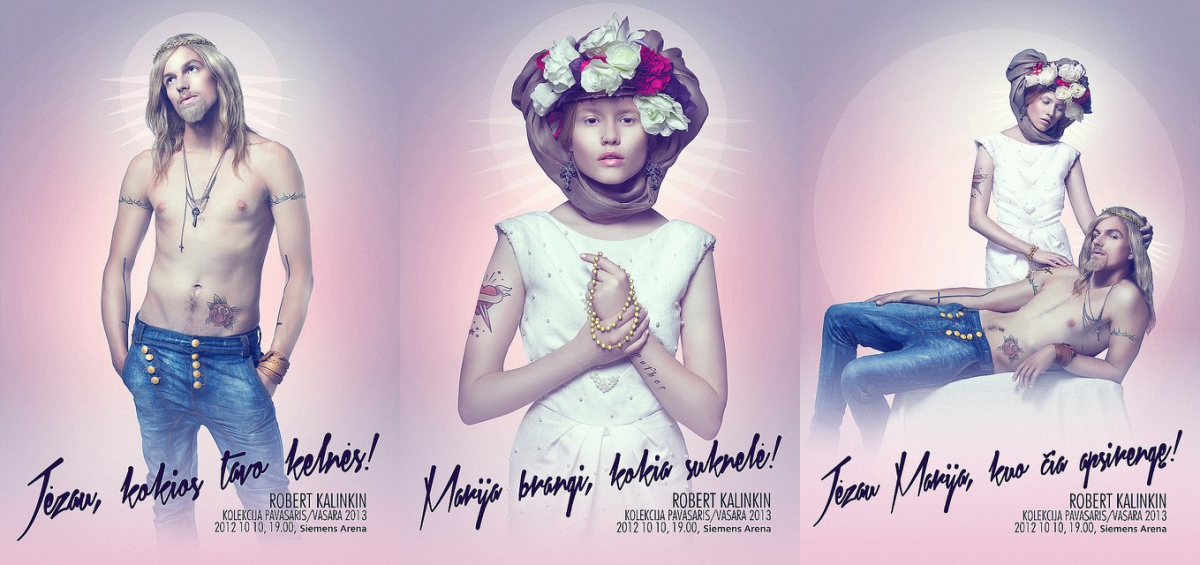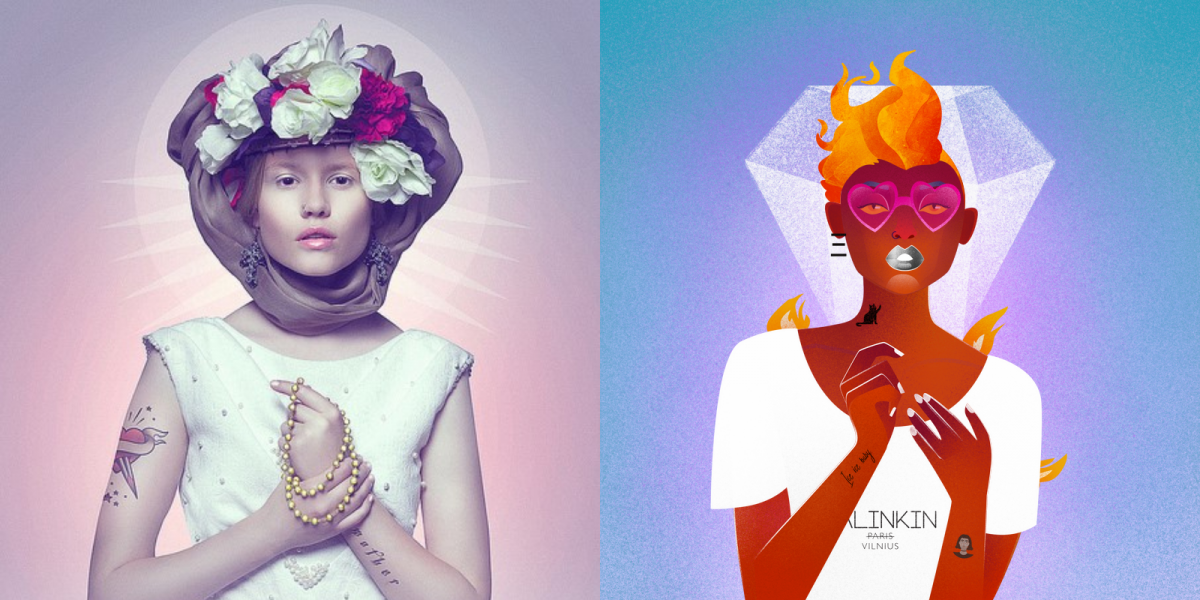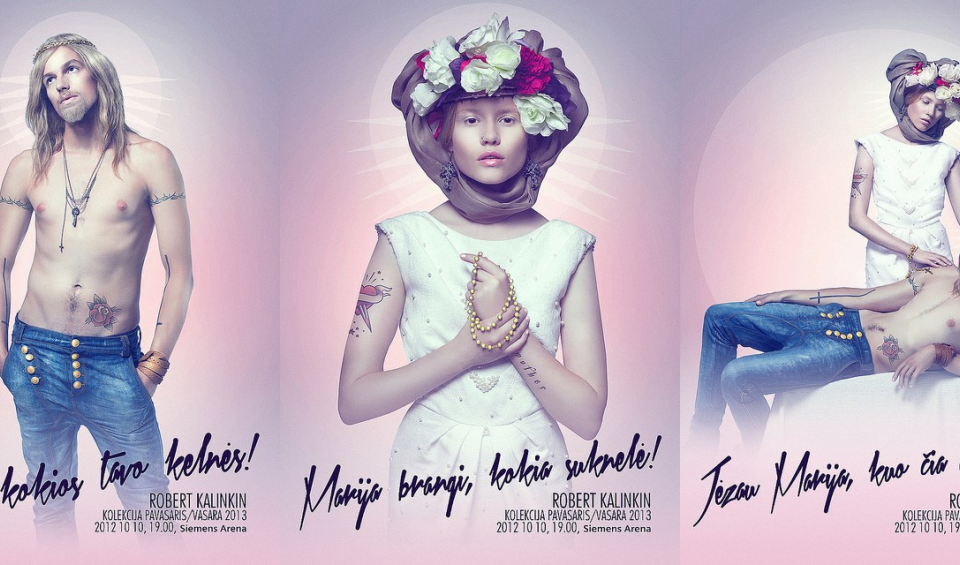How The Rebels Beat Censorship and Built an NFT Community
In the fall of 2012, in Vilnius, Lithuania, Robert Kalinkin Fashion House released an ad campaign that featured a man and a woman posing as Jesus and the Virgin Mary wearing jeans and a dress from the company’s then-upcoming clothing line. “Jesus, what trousers!” one of the taglines read, along with “Dear Mary, what a dress!” and “Jesus, Mary, what are you wearing?”
The campaign ran on the company’s website and on prominent billboards in the Lithuanian capital ahead of a fashion show that brand co-founders Robert Kalinkin and Indre Viltrakyte were organizing at the time. “It was a play of words,” Indre Viltrakyte, Robert Kalinkin co-founder and CEO said of the campaign while speaking to nft now. “We had the models, and those images were in very serene surroundings. They were a very aesthetic representation of our clothing. Everybody loved it.”
A few days before the fashion show, however, Viltrakyte and Kalinkin received a complaint from a church in a nearby city claiming they had violated public morals by insulting the image of Jesus, God, and Mary. Lithuania is one of the most devoutly Abrahamic countries on Earth, with more than 90 percent of its inhabitants identifying as Christians and three-quarters of its adults identifying as Catholic.
The complaint went to Lithuania’s State Consumer Rights Protection Authority (SCRPA), and on to the Lithuanian Advertising Agency (LAA), both of which ruled that the pair had offended the feelings of religious people, a principle enshrined in the country’s Code of Advertising Ethics.

“They gave us a choice,” Viltrakyte recalled. “Either accept [the ruling] and apologize publicly for that advertisement, or they would proceed and go to court. They felt we enraged the Lithuanian Catholic community. So, we said, ‘No, we cannot apologize for something we don’t think we did wrong.’”
The choice to resist the ruling incurred years of litigation. In the course of fighting the SCRPA’s decision, the fashion house lost three separate court cases, with the final blow coming from the Supreme Court of Lithuania. “But we still felt right in what we did,” said Viltrakyte. “It was a creative expression. Advertising is a form of creative expression.”
The European Court of Human Rights (ECHR) agreed. Lawyers took on the pair’s case pro bono, believing that the fines and rulings the Lithuanian courts dealt out had violated their right to freedom of expression as described in Article 10 of the European Convention on Human Rights. On January 30, 2018, after years of proceedings and paperwork, the ECHR declared the Lithuanian courts’ ruling unlawful, setting a precedent for the entire European Union.
“If you feel that something you’ve created has a right to live, nobody should take that from you.”
Indre Viltrakyte
“I read every line of that final [court judgment] with a sweet taste of justice for creatives,” Viltrakyte said. “If you feel that something you’ve created has a right to live, nobody should take that from you.”
The birth of the Rebels NFT project
In the spring and summer of 2021, Viltrakyte decided to take the same principles of creative expression and instill them in an NFT project. She began buying and trading NFTs, becoming “absolutely hooked” on Web3. “It came to me that we could immortalize our story on the blockchain,” Viltrakyte explained.
In September, Viltrakyte brought the idea to Kalinkin, and the two decided to base the project on the very ad campaign they had fought so hard for over the years. By November, The Rebels NFT community launched on Discord and Twitter, and in January 2022, the collection was minted into existence.
The Rebels team wanted the 10,101 NFTs in the collection to reflect Viltrakyte and Kalinkin’s journey. Ernesta Vala, the project’s art director (who also led the pair’s 2012 ad campaign), based the NFTs in the collection on the campaign’s portrayal of Mary.
“When we created the project, we wanted to create this character, this mother of mothers — proud and independent,” Viltrakyte explained. “When we saw those features were in the characters, we just let the Ernesta and the team do the rest.”

Getting into NFT fashion
The Rebel’s website states that the brand aims to become the first fashion house to transform into a blockchain brand fully. Viltrakyte makes no attempt to hide her traditional fashion roots, though, and believes her perspective and experience serve her well in exploring ways to bridge the physical and the digital in the realm of Web3.
“We are searching for ways to be the bridge between the physical and digital,” Viltrakyte said. “We know how to make clothes, we know the business side of that — we’re not digital natives and we don’t pretend to be.”
Viltrakyte and the Rebels team are launching their first clothing line in late September, which will include physical clothes and sneakers with digital NFT counterparts. Creating clothing items with NFT tags (making them traceable and verifiable) is a compelling possibility. Still, significant advances at the intersection of fashion and NFTs are currently hemmed in by what Viltrakyte calls “the interoperability problem.”
What is the interoperability problem? In short, it comes from the way self-contained metaverse spaces are siloed off from one another. For example, you may own a metaverse-compatible digital asset in one project’s digital environment, but you can’t take that asset to another metaverse. This lack of interoperability keeps projects and communities from interacting and Web3 from developing cohesively on a larger scale.
“Until this is solved, we cannot have a fully functional [Web3] fashion house,” Viltrakyte lamented. “It’s probably not coming anytime soon. If you do a fashion line for Decentraland, it’s only for Decentraland. And if you do one for Sandbox, it’s only for them. We’ll need to get around that. I have a deep conviction about VR technologies, where you can use wearables. And we’re working on something like that as well.”
“There are no boundaries there. Nobody to tell us we can’t create what we want to create.”
Indre Viltrakyte
The bigger picture, Viltrakyte believes, is to enable creators in the Web3 community to build, design, and create clothing of their own. “We’re working on building a platform that allows people with minimal design knowledge to choose the design elements in a way that the final garment looks unique and custom made,” Viltrakyte explained. “Then, we can open that to be transformed into whatever platform you desire, Decentraland, some other metaverse, or an AR filter.”
The success and future of the NFT fashion industry
Fashion brands like Gucci, Tiffany, Prada, and Nike have become fast friends with Web3. The success of these brands’ flirtations with NFTs is a good sign for the fashion industry, though Viltrakyte said she hopes these companies follow through with their Web3 commitments.
“It’s important these brands continue to [experiment] with NFTs,” Viltrakyte remarked. “If it’s just one or two drops, that’s bad for the space because then there’s no consistency, and you can just write it off as a cash grab. I generally think that fashion is just more visible than other industries because it’s a luxury thing, and everyone wants a piece of that. Things like DeFi just aren’t so sexy.”
Viltrakyte believes that fashion is well-suited for Web3 because what people decide to wear has always been the most basic form of self-expression. If the identity-crafting focus of NFTs and blockchain technology has a parallel in anything, it’s fashion. Whichever brands best recognize and capitalize on that will carry the torch forward.
“There will be heritage luxury brands who nail that,” Viltrakyte said, speaking on her predictions for the future of Web3 fashion. “Tiffany has a good shot at it. I’m betting they’re going to be consistent with [Web3]. Then, there will be brands like us who come from a small background. Small, boutique, quite high-end brands from a small country nobody knows about, going into this huge Web3 world. There are no boundaries there. Nobody to tell us we can’t create what we want to create.”
The post How The Rebels Beat Censorship and Built an NFT Community appeared first on nft now.

